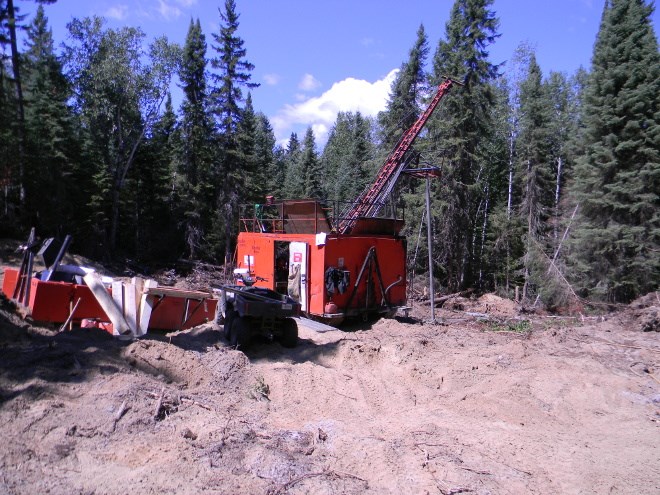Ryan Samis isn’t ready to say mining exploration is out of a dark period, but there’s light at the tunnel.
The president of the Canadian Diamond Drilling Association said the prevailing sentiment heading into 2017 is upbeat in comparison with recent years.
“It’s kinda like you want to believe that it’s finally going to come back this year,” said Samis, who works for Geotech Drilling’s exploration division manager based in Prince George, B.C.
“At the end of each year clients are looking at budgets and from what I’ve seen…programs are getting bigger, flow-through is getting better, and there is more demand (for drilling services),” said Samis.
Geotech, which sends drill rigs across Canada and around the world, has been involved in three legacy gold programs for several years, he said.
“All three are ramping up to be some of the biggest programs we’ve done in those years.”
The mining industry enjoyed a super cycle between 2003 and 2007, followed by a sharp recession in 2008/09 that hit exploration particularly hard, coupled with declining mineral commodity prices.
Samis said Geotech has remained active, working on projects financed by a combination of private investors and flow-through funds.
“I think the (financial) market has loosened a bit. People are starting to see gold as something to go back into and the worldwide stockpile of resources has started to go down because mining wasn’t there.”
His association doesn’t keep drill rig utilization rates, but Samis mentions that of his company’s 42 drills between 50 to 60 per cent are in the field.
More than half are engaged in mineral exploration with the rest being geotechnical work for infrastructure projects.
“I’d say, it’s similar for the majority of contractors.”
The annual junior mining report released last fall by Pricewaterhouse Coopers Canada (PwC) found the exploration industry is gradually moving in the right direction.
PwC reported a rise in the market capitalization of the top junior mining companies on the TSX Venture Exchange by more than 100 per cent compared to 2015. Global political and economic uncertainty helped the exploration sector by boosting gold prices as much as 22 per cent.
“While the outlook is positive, it’s too early to call it a recovery,” wrote Liam Fitzgerald, PwC Canada’s national mining leader, in the report. “For the past few years, executives have had to look at different and creative ways to allocate resources and capital.
As investors renewed their interest in junior assets, we’re now seeing market valuations close to what they were in 2012 which is encouraging.”
But with companies, more or less, the same position of the mining lifecycle as the previous year, despite some positive signs, the report warned markets are volatile and “there is no room for complacency.”
Whether the drilling industry can find top-notch crews to man those rigs during the recovery is another story.
Coming out of the doldrums, Samis said the biggest challenge will be sourcing labour.
The extended downturn forced some experienced hands to look for more stable careers, said Samis.
“To fill the void in positions, you’ll have a greener, less experienced individuals that come in and do less of a professional job or maybe the health and safety (knowledge) isn’t where it should be because people don’t have the experienced backing them.”
Garry Clark, the Ontario Prospectors Association’s executive director, is concerned about the exodus.
“We’ve gone through four-plus years of downturn, and people – specifically suppliers, contractors, geologists, and those working on the ground – have started other things outside of the industry.
“They won’t come back if there’s only a two or three-month contract because they’ve got a full-time salary somewhere else. Until things are consistent for a longer period, we’re short of people and skilled trades.”
Clark remains “guardedly optimistic” heading into 2017 compared to the same period last year when the financing environment for exploration hit rock bottom.
“The price of gold – in the $1,200 an ounce range – is still good and there have been good successes around some old mines and brownfields with the Richmont’s and Wesdome’s finding new zones.
“Some of the mergers and acquisitions that happened have strengthened a lot of companies, and it provides a huge base for them to move forward.”
Clark said it will be more advantageous for suppliers to put together one bid for larger merged companies with multiple operations, leaving less stock on the shelves.
Plus, there are new opportunities at the New Gold mine construction project near Fort Frances, Treasury Metals advanced gold project at Dryden, and the Greenstone Gold joint venture outside Geraldton.
Clark said the industry needs incentives to keep dollars flowing through difficult times.
He credits the provincial Junior Exploration Assistance Program (JEAP) for keeping early-stage projects alive.
The $5-million incentive program, funded by the Northern Ontario Heritage Fund and administered by the prospectors association, reimburses one-third of eligible expenses for up to two early stage exploration projects per applicant.
Maximum assistance is limited to $100,000 per project.
Early stage exploration can include prospecting, line cutting, ground or airborne geophysics, stripping and trenching, diamond drilling and assaying.
There’s an additional $6,000 available per project to hire or train local First Nation members.
In early December, 62 applications have been submitted for the JEAP 2016 program with 50 being approved.
“It’s been well touted by the companies that have been accepted,” said Clark, who adds there have been some “technical successes” on the grass-roots level.
These involved projects with a total proposed spending of approximately $13 million with $3.75 million applied for in grants.
On the federal side, prospectors were still waiting to hear if Ottawa was going to renew the federal flow-through share program – a tax-based financing incentive used in exploration.
“Keeping flow-through around is a big concern of ours,” said Clark. “If you turn it off right now it would cripple the industry.”


.jpg;w=120;h=80;mode=crop)

